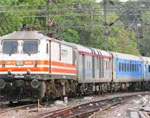|
Destination News |
|
|
|
|
|
|
India's fastest
train completes final test run in record time The sixth and final trial for Gatimaan Express, the first semi high-speed train service between Delhi and Agra, was completed on Tuesday, during which the train covered the 195-km journey in 115 minutes, clocking a maximum speed of 160-plus kmph. Prime Minister Narednra Modi is expected to flag off the train, touted to be the country's fastest, in the second week of June. Equipped with a 5,400HP electric locomotive and 12 modern coaches, the train, however, arrived 10 minutes late as it was expected to cover the journey in about 105 minutes. Bhupinder Dhillon, public relations officer for divisional railway manager (DRM), Agra, told TOI, "It was the last trial run of Gatimaan Express, which was conducted by the maintenance department of Northern Railway. So, now we can expect the train to be flagged off soon." Another senior official said, "The clearance from CRS is expected any time and we are gearing up to launch the train. Plans are afoot to have the PM flag off the train in the second week of this month." Railways is celebrating Modi government's completion of one year in office with a fortnight of programmes from May 26 to June 9. On Tuesday, the train, which has no stoppages in its 195-km route, began its journey from New Delhi station at 11.15 am and arrived at Agra Catt station at 1.10 pm, 10 minutes later than its correct time. On its journey back, the train started from Agra Cantt at 2.20pm and reached Delhi at 4.25pm, taking a total time of 2 hours 25 minutes. Interestingly, the current fastest train, Bhopal Shatabdi, takes 2 hours six minutes to cover the same distance, including a two-minute halt at Mathura. The running schedule of the train as well as its fare have already been decided by the railway authorities. The fare for Gatimaan Express will be 25% more than what a Shatabdi passenger has to pay. One-way fare of the air-conditioned chair car has been fixed at Rs 690, while a passenger will be required to spend Rs 1,365 for the executive class. For Shatabadi, a passenger is required to pay Rs 540 for a chair car seat and Rs 1,040 for the executive class. The train is expected to start from New Delhi at 8 am and reach Agra by 9.45am. On its journey back, the train will start from Agra at 5.30 pm are reach Delhi at 7.15pm. Flowery carpet awaits tourists: Valley of flowers to reopen from June 1 Flowers sway and flowers charm - all around the world. Flowers cheer us all. They inspire poems and songs that melt hearts. Flowers are intricate to our myriad emotions as we navigate through the days and nights in this beautiful world. All of that will now get a fillip with the reopening of the famous Valley of Flowers in Chamoli district of Uttarakhand. Located between the altitudes of 3,352 metres and 3,658 metres above sea level, the Valley will technically reopen for the five month-long season, beginning on June 1. To help enthusiasts and tourists visit the serene locale, the National Park's authority has decided to realign the trekking route to the Valley, bypassing the previous route which had got badly damaged due to 2013 flash floods. The Valley will reopen for the entire season after a gap of two years. The state PWD has constructed a new bridge at Dwari from where the tourists will trek to the Valley using a new route which was earlier used by the shepherds. With the slated reopening of the Valley, local villagers are hopeful that it will boost their income. They are hoping that by setting up dhabas and hotels, and by working as guides, they will be able to add to their income. Located in the majestic backdrop of Zanskar ranges, the Valley is considered as a virtual paradise on earth. Known for its meadows of endemic alpine flowers and the variety of flora, the Valley of Flowers is a World Heritage Site. It was declared as a National Park in 1982. This richly diverse gentle landscape is also home to many rare and endangered animals. In 1931, British mountaineers Frank S. Smythe, Eric Shipton and R.L. Holdsworth lost their way while returning from an expedition to Mt. Kamet. Out of the blue they reached the Valley, which was full of flowers. They named it as the Valley of Flowers. The Valley is also associated with the Ramayana and it is believed that Lord Hanuman brought the 'Sanjeevani' herb for ailing Lakshmana from there. |
